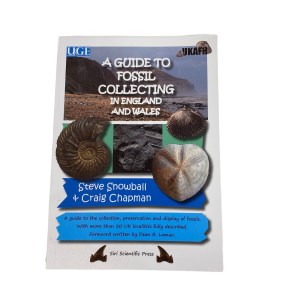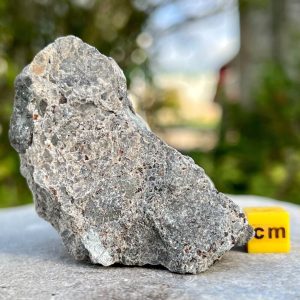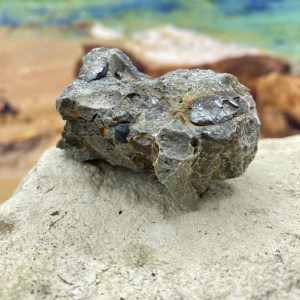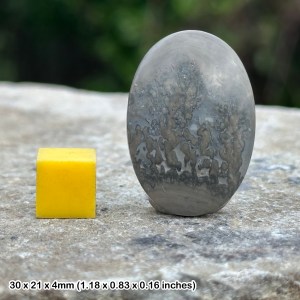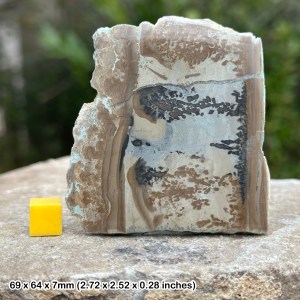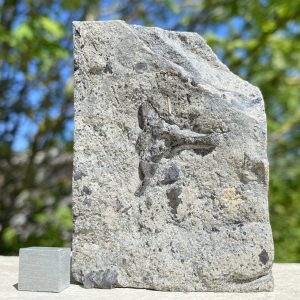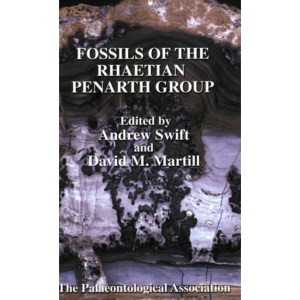The famous red and white cliffs that can be seen when crossing the River Severn contain a highly productive bone bed at the top from the Rhaetian Penarth series. This bed is full of teeth, and reptile and fish remains, and is the most productive Triassic site in the UK.
DIRECTIONS
♦ Aust is located on the eastern side of the Severn estuary, close to the eastern end of the Severn Bridge.
♦ Access to the cliffs from Junction 1 of the M48 is through a steel gate, over a stile onto a concrete causeway. Parking is on the B4461 Aust Wharf Road at Old Passage.
♦ Walk along Passage Road towards the bridge, until you get to the beach.
♦ Ref: 51.60334°N, 2.62888°W
PROFILE INFO
FIND FREQUENCY: ♦♦♦♦♦ – Fossils are regularly found at Aust and just a small amount of the famous bone bed can yield a high number of teeth, coprolites and bone fragments. And, even if you cannot find any of these blocks, there are plenty of Carboniferous molluscs to search for. The blocks of Aust bone bed are highly collected, so are usually quickly broken down by collectors. However, the broken down smaller pieces of bone bed can usually be broken down further.
CHILDREN: ♦♦♦♦ – Aust is suitable for children, provided they are supervised by an adult. Keep to the southern side of the bridge and do not walk round to the northern side. And keep away from the cliffs and mudflats.
ACCESS: ♦♦♦♦ – Aust is easy to access, providing that you stick to the southern side of the bridge. The northern side is much more difficult to access and should only be visited by experienced collectors, wearing appropriate footwear. There are no toilets near Aust.
TYPE: – Fossils at Aust are found on the foreshore from the beds at the top of the cliff. The rest of the cliff section is unfossiliferous, so you will need to search the fallen blocks on the foreshore and in the areas of shingle.
FOSSIL HUNTING
There are cliffs at Aust both on the north and south side of the bridge. When you reach the foreshore, you are on the southern side, which is currently being washed out more than the northern side. To access the northern side, you will need to wait until the tide is low enough to walk around the concrete bridge support. Take extreme care if accessing this area, as it can be slippery with mudflats. Return before the tide turns to avoid being cut off.

Look out for shells, and loose bones, teeth and bone fragments in the areas of shingle. Occasionally, you can come across large lumps of the bone bed, although lumps of the bone bed are usually quite small because collectors have already split them down. You only need a small amount of the bed to get some finds. Common fossils are shark and fish teeth, and fish scales and coprolites. Fragments of bone are also very common and often are from ichthyosaurs and plesiosaurs, but identifiable bones are less common. You can also find fossil clams and oysters. However, it is a very popular location for collecting fossils, so competition means that the bone bed blocks are becoming harder to find. However, in recent times, the south side of the bridge is regularly washing out, with fresh cliff falls, giving rise to a good amount of material to search through.

The Red Marls are unfossilferous, so there is no point in searching within this layer. The bone bed comes from the top of the cliff at the base of the Lower Lias and is unreachable. Therefore, finding fossils at this location is dependent on cliff falls.

GEOLOGY
This Middle and Late Triassic and Early Jurassic site lies south (downstream) of the Severn Bridge and can be seen as the familiar white and red cliffs. It is one of the UK’s few productive Triassic fossil collecting localities.
Here, the red beds of the Mercia Mudstone Group (formerly the Keuper Marls) from the Branscombe Mudstone Formation (which is 206 to 221myrs old) at the cliff base, pass upwards to the green-grey beds of the Blue Anchor Formation, which is 206 to 221myrs old (formerly the Tea Green Marls). These rest on the darker, then lighter, grey beds of the Penarth Group. These consist of the Westbury Formation and Cotham Member (formerly the Rhaetic Beds) from the Late Triassic or Rhaetian (which is 206 to 210myrs old). At the cliff top are the light brown beds of the Blue Lias Formation from the Early Jurassic.
The Branscombe Mudstone Formation at the cliff base is unfossiliferous. It is the beds of the Penarth Group that contain the bone bed, so collecting is totally reliant on cliff falls.


SAFETY
Common sense when collecting at all locations should be used and knowledge of tide times is essential. There are several dangers at Aust and these become more apparent if you plan to collect from the northern side of the bridge. To get there, you will need to walk round a pillar of the bridge when the tide is retreating. However, this is slippery and often has dangerous mudflats. You can also easily get cut off by the tide if you do not return before the tide starts to come in.
Keep away from the cliff as this can fall or crumble at any time, and keep away from the mud on the foreshore which can be dangerous. And beware of the Severn Bore (a large wave that happens several times a month and is created as the tide flows up the river into an increasingly narrow space). Times for this are advertised at: www.severn-bore.co.uk.
EQUIPMENT
Fossils can only be collected from the foreshore, especially along the tide line. However, any large lumps of the bone bed will require strong tools to split them up. A good eye is often all you need, but a geological hammer, chisels and eye protection may be necessary for the larger lumps.

ACCESS RIGHTS
Although not an official right of way to the beach, the council and National Grid allow the use of the raised road, for walking but not for vehicles. An information board explaining this is at the end of this raised road.
This site is a site of special scientific interest (SSSI). This means you can visit the site, but hammering the bedrock is not permitted. For full information about the reasons for the status of the site and restrictions, download the PDF from Natural England.
It is important to follow our ‘Code of Conduct’ when collecting fossils or visiting any site. Please also read our ‘Terms and Conditions‘
LINKS
♦ Buy Fossils, Crystals, Tools
♦ Location Discussions
♦ Deposits Magazine
♦ Join Fossil Hunts
♦ UK Fossils Network
-
A guide to fossil collecting in England and Wales
£24.20 -
Aust Fossil Bone Bed – Sedimentary, UK Seller
£8.40 -
Black Selenite Crystals, Aust, UK British Mineral
£30.00 -
Bone Bed, Aust, Triassic (rock sample)
£3.12 -
Cothan marble stromatolite cabochon fossil – triassic period, uk
£14.40 -
Cothan marble stromatolite fossil – triassic period, uk
£17.88 -
Fossil Pachystropheus Reptile Vertebrae, Triassic, Aust, Bristol, UK
£57.60 -
Fossils of the Rhaetian Penarth
£15.40 -
Rare Hybodus Triassic Shark Tooth Fossil – Aust Cliff, Upper Triassic – COA Included
£48.00









































